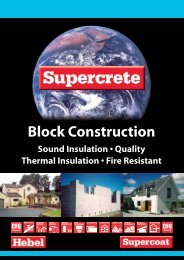Structural Floor Panels Design Guide - Hebel Supercrete AAC ...
Structural Floor Panels Design Guide - Hebel Supercrete AAC ...
Structural Floor Panels Design Guide - Hebel Supercrete AAC ...
You also want an ePaper? Increase the reach of your titles
YUMPU automatically turns print PDFs into web optimized ePapers that Google loves.
3.2 Lifting<br />
3.2.1 Crane and Lifting Procedure.<br />
The bundles of panels are un-strapped and the first panel<br />
rolled off the supporting timber strapping blocks and laid<br />
on its flat, using car tyres, or similar, as a cushioning support.<br />
Position the tyres to allow the lifting cradle to get access to<br />
the panel at mid span. Ensure the panel is sitting with the<br />
top surface up. This is the face with the ring anchor grooves<br />
on the top edge.<br />
Using lifting strops (rated for the load).<br />
A variety of lifting devices can be used. Even a 5.6 metre<br />
long 250mm thick panel weighs less than 600kg and more<br />
typical 4 metre, 150mm thick panels weigh in at around<br />
250kg each. This means that panels have been installed<br />
using small truck-mounted cranes, fork trucks and tractors,<br />
gantry cranes, even stropped off a digger bucket arm. The<br />
key consideration is not usually the weight of the panel to<br />
be lifted, but rather the reach of the crane/lifting machinery<br />
being used.<br />
Lifting with a forklift<br />
Driver/operator visibility may also play a part in crane<br />
choices, although on lifts to multi storey buildings, the<br />
operator is often unable to see the drop zone and relies on<br />
good radio communication with the install crew to position<br />
the panel.<br />
The <strong>Supercrete</strong> Panel cradle is a clamp that fits to the<br />
lifting chain/cable of the crane. It is swung into position at<br />
the mid span of the panels that have been laid flat on the<br />
tyre supports. A lever opens the jaws of the cradle and<br />
once the weight of panel is applied as the lift commences,<br />
the jaws clamp shut. Safety chains wrap around the panel<br />
to ensure it does not slip out. These chains are removed as<br />
the panel is placed.<br />
A lifting cradle in use. Safety chain detached<br />
for placement.<br />
3.2.2 Panel Placement Times<br />
Panel placement times vary depending upon the following<br />
factors;<br />
a) How close the bundles of panels can be delivered to<br />
the intended position on the building<br />
b) The speed of the horizontal travel of the crane boom<br />
c) Whether the panels need to be cut to size on site.<br />
d) The rhythm, or efficiency of the team of personnel<br />
e) The adequacy of the support system (walls and beams<br />
in the right place and at the correct levels)<br />
Times ranging from 5 to 6 minutes per panel for simplistic<br />
easily placed panels up to 15 minutes per panel for<br />
complicated layouts (including panel cutting, or difficult site<br />
access, slow cranes, etc) have been reported. This gives<br />
between 4 and 10 panels per hour. Depending upon the<br />
surface area of the panels, square metre rates will vary<br />
accordingly.<br />
Lifting cradles are fitted to truck mounted<br />
cranes.<br />
SFP 2012 44 Copyright © <strong>Supercrete</strong> Limited 2008



